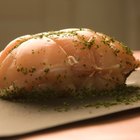
Pig tongue, or pork tongue, won't be on everyone's list of go-to ingredients or even experimental ingredients, but for some it's just another way to add flavor and character to a dish. The tongue is different in texture than any other part of the pig, so you can't just fry it up or toss it in the oven and expect a quality result. Special considerations are required to get the pig tongue to a point that it makes a tasty addition to the meal.
Brining
Brining your pork tongue is not an essential step just to cook it, but it will add tenderness and flavor, just as brines do with any tough meat. A standard brine made with salt, water and sugar works well for pig tongue; a soak for 12 to 24 hours will yield quality results. Remember to weigh the tongues down in the brine with a plate or another container so they remain submerged; place the container in the refrigerator until brining is complete. You can also buy pig tongues that have been commercially brined.
The Peeling Factor
Pork tongue has a skin on the exterior that must be peeled off before you can eat it, or you'll have little success. The tongue must be hot or warm to peel it, so many cooks poach it first. After brining -- if you use that step -- place the tongues in simmering water on your stovetop and let them poach for up to two hours. After poaching, remove the tongues and allow them to cool so you can handle them, then peel the outer layer of skin off. From there, you can add the tongue to your dish or slice it thin and pan fry it until it's browned; serve it as is.
Braising
Braising is a form of slow cooking that enables you to tenderize the tongue and add flavor with your choice of braising liquid and extras. Add the tongues to a pot and cover them with water or stock, then add herbs like thyme and bay leaf. Bring it to a boil and then reduce the heat to a simmer and cover the pot. When the tongues are finished, you should be able to insert a knife easily into the flesh. It could take up to four hours of braising for this to happen. Remember to peel the tongues after they are braised.
Experimentation
Since eating pig tongue isn't on the main menu for a lot of cooks, it's ok to use some experimentation when trying it out. Slow-cooked preparations like confit produce a tender pork tongue, and after the initial poaching and peeling you can add it to stews and other slow-cooked dishes that will allow the tissues to break down. If you decide to try a cultural dish that features pork tongue, follow the instructions as closely as possible to ensure a flavorful and tender end result.
Related Articles

How to Cook Fresh Pork Tongue

How to Cook Lengua in a Slow Cooker

How to Cook Beef Tongue Mexican Style
How to Brine & Smoke Pork Belly

How to Do Corned Pork

How to Avoid Bad Breath With a Tongue ...
How to Cook Dried Abalone

How to Get the Tongue of Your Shoe to ...

How to Roast Beets for Canning or ...

How to Tie a Ghillie Shirt

How to Cook Smoked Pork Knuckles

How Should You Cook a Hog Stomach?

How to Boil Frozen Conch

How to Care for a Rook Piercing

How Can I Bake a Pork Loin Roast So ...

How to Cook With Pork Jowl

How to Poach Split Bone-In Chicken ...

How to Brine Pork Loins

How to Clean a Tongue Ring

How to Clean the Tongues of Shoes
References
Writer Bio
Joshua McCarron has been writing both online and offline since 1995. He has been employed as a copywriter since 2005 and in that position has written numerous blogs, online articles, websites, sales letters and news releases. McCarron graduated from York University in Toronto with a bachelor's degree in English.
Photo Credits
Jupiterimages/BananaStock/Getty Images